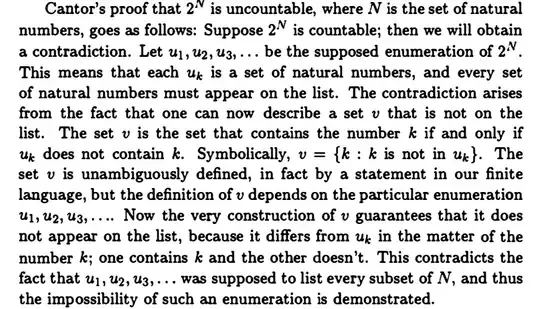What confuses you is possibly the appeal to contradiction, which is by no means necessary.
The book actually proves the following statement:
Suppose $u_1,u_2,\dots,u_n,\dotsc$ is a sequence of (pairwise distinct) subsets of $N$. Then there exists a subset $v$ of $N$ such that $v\ne u_n$, for every $n$.
The subset is built from the given sequence by
$$
v=\{k: k\notin u_k\}
$$
Indeed, let $n$ be a natural number: either $n\in v$ or $n\notin v$.
In the first case, $n\notin u_n$ by the very definition of $v$, so $v\ne u_n$; in the second case, $n\in u_n$, again by the very definition of $v$, so $v\ne u_n$. In both cases $v\ne u_n$.
In particular, no countable subset of $2^N$ can equal $2^N$, because from a countable subset we can produce an element of $2^N$ that is not in the given subset.
The more general statement that $|2^X|>|X|$, for every set $X$, can be proved similarly. Since, clearly, $|X|\le|2^X|$, the assert follows from
There is no surjective map $f\colon X\to 2^X$.
Indeed, suppose $f\colon X\to 2^X$ is any map. Define
$$
V=\{x\in X:x\notin f(x)\}
$$
Let us show that $V\ne f(x)$, for every $x$. Indeed, for $x\in X$ there are two cases
- $x\in V$
- $x\notin V$
In the first case $x\notin f(x)$, so $V\ne f(x)$. In the second case, $x\in f(x)$, so $V\ne f(x)$.
Therefore $f$ is not surjective.
The idea of the proof, as you see, is the same (and goes back to Cantor himself).
